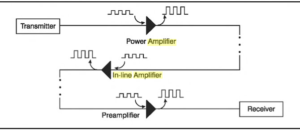In fiber optic communication systems, problems arise from the fact that no fiber material is perfectly transparent. The visible-light or infrared beams carried by a fiber are attenuated as they travel through the material. This necessitates the use of optical amplifiers. And EDFA (Erbium Doped Fiber Amplifier) is a representative one in the optical amplifier. There is one saying that EDFA is the most popular optical amplifier in optical network communications. Next, we will begin with the definition of EDFA.
An EDFA, also called optical amplifier or an erbium-doped fiber amplifier or erbium amplifier, is an optical or IR (Infrared Radiation) repeater that amplifies a modulated laser beam directly, without opto-electronic and electro-optical conversion. The device uses a short length of optical fiber doped with the rare-earth element erbium. When the signal-carrying laser beams pass through this fiber, external energy is applied, usually at IR wavelengths. This so-called pumping excites the atoms in the erbium-doped section of optical fiber, increasing the intensity of the laser beams passing through. The beams emerging from the EDFA retain all of their original modulation characteristics, but are brighter than the input beams.
The above picture illustrates the three major applications for optical fiber amplifiers: booster, in-line amplifier, and pre-amplifier. These applications are described in more details below:
Booster amplifiers are placed directly after the optical transmitter. In this application, booster amplifier is adopted to compensate for the losses of optical elements between the laser and optical fibers so that the increased transmitter power can be used to go further in the link.
In-line amplifiers or in-line repeaters are placed along the transmission link to compensate for the losses incurred during propagation of optical signal. They take a small input signal and boost it for re-transmission down the fiber. Here it should also be pointed out that to control the signal performance and the noise added by the EDFA is important, because noise added by amplifier will limit the system length.
Pre-amplifiers are placed just before the receiver to increase the signal level before the photodetection takes place in an ultra-long haul system so as to improve receiver sensitivity. By placing a pre-amplifier, a much larger signal can be presented to the receiver, thus easing the demands of the receiver design.
By now, you should have a basic idea of what an EDFA is and what it is used for, next I will introduce you some truly excellent EDFA products on the market.
|
Type
|
Description
|
| 22dBm Output Booster DWDM EDFA C-band 24dB Gain, 1U Rack Mount | |
| 16dBm Output Mid-stage DWDM EDFA C-band 26dB Gain, Plug-in Card for FMT Multi-Service Transport System | |
| 17dBm Output Mid-stage DWDM EDFA C-band 17dB Gain, Plug-in Card for FMT Multi-Service Transport System |
Of the various technologies available for optical amplifiers, EDFA technology is the most advanced, and consequently the vast majority of optical amplifiers are designed based on this technology. In addition, the combination of reliable performance and relatively low cost allows EDFA to be widely deployed in modern optical networks.

